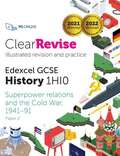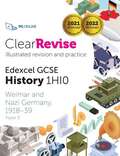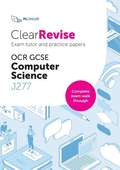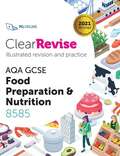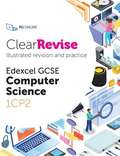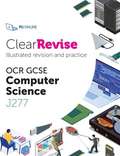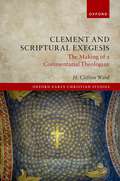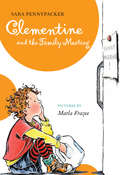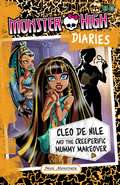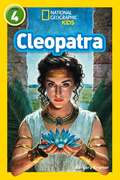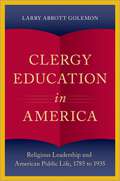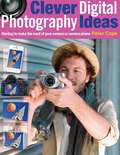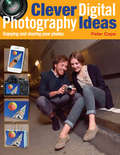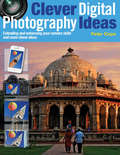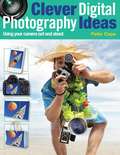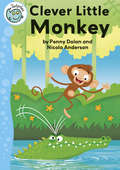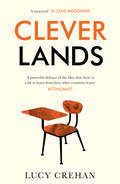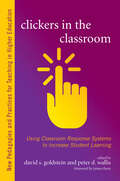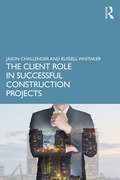- Table View
- List View
ClearRevise Edexcel GCSE History 1HI0 Superpower relations and the Cold War
by Pg OnlineIllustrated revision and practice. Covers Paper 2 for Edexcel GCSE History. Over 200 marks worth of examination style question. Specification references for every topic. Examination tips and techniques.
ClearRevise Edexcel GCSE History 1HI0 Superpower relations and the Cold War
by Pg OnlineIllustrated revision and practice, Covers Paper 2, for Edexcel GCSE History. Over 200 marks worth of examination style questions. Examination tips and techniques. Specification references for every topic.
ClearRevise Exam Tutor OCR GCSE Computer Science J277 (PDF)
by Pg OnlineClearRevise is all about making your revision easy. At the end of the course, doing practice papers is useful – but an exam tutor can make a big difference. This book helps provide support from both angles and will really help you to ace the exam. The first section is your exam tutor. It shows you example questions with model answers. Just like a tutor, it gives you exam tips and lets you know what the examiner is looking for. Secondly, you are then given similar questions from the same topic for you to have a go at, applying your knowledge and tips. With over 400 marks in this section and all the answers provided you’ll easily revise the topics as you go. Lastly, there are two complete exam papers written in the same style as the live OCR papers to try. They're exactly the same length and marks as the real exam, providing a realistic experience and a great opportunity to show how much you've progressed.
ClearRevise GCSE AQA Food Preparation & Nutrition 8585
by Pg OnlineIllustrated revision and practice, with over 650 marks worth of examination style questions. Answers provided within the book. Specification references for every topic. Examination tips and techniques. Each specification topic has been referenced and distilled into the key points to make in an examination for top marks. Questions on all topics assessing knowledge, application and analysis are all specifically and carefully devised throughout this book.
ClearRevise Illustrated Revision and Practice Edexcel GCSE Computer Science 1CP2
by Pg OnlineIllustrated revision and practice: Absolute clarity is the aim with a new generation of revision guide for the 2020s. This guide has been expertly compiled and edited by successful former teachers of Computer Science, highly experienced examiners and a good dollop of scientific research into what makes revision most effective.
ClearRevise OCR GCSE Computer Science J277
by Pg OnlineAbsolute clarity is the aim with a new generation of revision guide for the 2020s. This guide has been expertly compiled and edited by successful former teachers of Computer Science, highly experienced examiners and a good dollop of scientific research into what makes revision most effective. Past examinations questions are essential to good preparation, improving understanding and confidence. This guide has combined revision with tips and more practice questions than you could shake a stick at. All the essential ingredients for getting a grade you can be really proud of. Each specification topic has been referenced and distilled into the key points to make in an examination for top marks. Questions on all topics assessing knowledge, application and analysis are all specifically and carefully devised throughout this book.
ClearRevise OCR GCSE Physical Education J587
by Pg OnlineAbsolute clarity is the aim with a new generation of GCSE revision guides. This clear study guide has been expertly compiled and edited by successful teachers of PE, highly experienced examiners and a good dollop of scientific research into what makes revision most effective and more accessible. It covers each of the different optional topics. Contains over 350 marks worth of examination style questions. Answers provided for all questions within the book.
Clement and Scriptural Exegesis: The Making of a Commentarial Theologian (Oxford Early Christian Studies)
by H. Clifton WardHow might one describe early Christian exegesis? This question has given rise to a significant reassessment of patristic exegetical practice in recent decades, and H. Clifton Ward makes a new contribution to this reappraisal of patristic exegesis against the background of ancient Greco-Roman education. In tracing the practices of literary analysis and rhetorical memory in the ancient sources, Clement and Scriptural Exegesis argues that there were two modes of archival thinking at the heart of the ancient exegetical enterprise: the grammatical archive, a repository of the textual practices learned from the grammarian, and the memorial archive, the constellations of textual memories from which meaning is constructed. In a new treatment of the theological exegesis of Clement of Alexandria-the first study of its kind in English scholarship-this study suggests that an assessment of the reading practices that Clement employs from these two ancient archives reveals his deep commitment to scriptural interpretation as the foundation of a theological imagination. Clement employs various textual practices from the grammatical archive to navigate the spectrum between the clarity and obscurity of Scripture, resulting in the striking conclusion that the figurative referent of Scripture is one twofold mystery, bound up in the incarnation of Christ and the higher knowledge of the divine life. This twofold scriptural mystery is discovered in an act of rhetorical invention as Clement reads Scripture to uncover the constellations of texts-about God, Christ, and humanity-that frame its entire narrative.
Clement and Scriptural Exegesis: The Making of a Commentarial Theologian (Oxford Early Christian Studies)
by H. Clifton WardHow might one describe early Christian exegesis? This question has given rise to a significant reassessment of patristic exegetical practice in recent decades, and H. Clifton Ward makes a new contribution to this reappraisal of patristic exegesis against the background of ancient Greco-Roman education. In tracing the practices of literary analysis and rhetorical memory in the ancient sources, Clement and Scriptural Exegesis argues that there were two modes of archival thinking at the heart of the ancient exegetical enterprise: the grammatical archive, a repository of the textual practices learned from the grammarian, and the memorial archive, the constellations of textual memories from which meaning is constructed. In a new treatment of the theological exegesis of Clement of Alexandria-the first study of its kind in English scholarship-this study suggests that an assessment of the reading practices that Clement employs from these two ancient archives reveals his deep commitment to scriptural interpretation as the foundation of a theological imagination. Clement employs various textual practices from the grammatical archive to navigate the spectrum between the clarity and obscurity of Scripture, resulting in the striking conclusion that the figurative referent of Scripture is one twofold mystery, bound up in the incarnation of Christ and the higher knowledge of the divine life. This twofold scriptural mystery is discovered in an act of rhetorical invention as Clement reads Scripture to uncover the constellations of texts-about God, Christ, and humanity-that frame its entire narrative.
Clementine and the Family Meeting (Clementine #5)
by Sara PennypackerThis New York Times bestselling chapter book series has been keeping readers engaged and laughing for more than a decade with over one million copies sold! Clementine's having a nervous breakdown. The FAMILY MEETING! sign is up in her house, and she just knows she's in trouble for something. Has she been too mean to her little brother? Too sloppy? Eating too much junk food? Try as she might to find out what's on the agenda, her parents won't reveal anything before the meeting. As far as Clementine is concerned, the agenda should be something like: "We're getting a gorilla." But no, it's something entirely different. "We're talking about a new baby," says her father. "A sibling for you two. What do you think about that?" NO THANKS! is what Clementine thinks. After all, four is the perfect number for a family. There are four sides to a table, not five. Will Clementine learn to make room for one more?
Cleo De Nile and the Creeperific Mummy Makeover: Cleo De Nile And The Creeperific Mummy Makeover Monster High Diaries: Cleo De Nile (Monster High Diaries)
by Nessi MonstrataThe fifth book in the popular Monster High Diaries series, featuring Cleo De Nile!Dear Diary,Oh my Ra! My mom is coming home! She's been trapped in a tomb this whole time! I hope the tomb was filled with creeperific gems and creepy-cool artefacts. Otherwise I can't imagine how my poor mom coped. I am going to throw the most awesome welcome-back party for her. I know this might be hard to believe, but I'm a little worried about whether the party will be glamorous enough for her. Oh, what am I saying? OF COURSE it will be! I'm just the ghoul for the job!Royally yours, Cleo © 2016 Mattel. All Rights Reserved.
Cleopatra: Level 4 (National Geographic Readers Ser.)
by Barbara Kramer National Geographic KidsNational Geographic Primary Readers is a high-interest series of beginning reading books that have been developed in consultation with education experts. The books pair magnificent National Geographic photographs with lively text by skilled children’s book authors across four reading levels. Explore one of the most recognised people in history with the biography of Cleopatra. Kids will learn about her life, achievements, legacy, and why she continues to fascinate generations of readers. Level 4: Independent reader: Perfect for kids who are reading on their own with ease and are ready for more challenging vocabulary with varied sentence structures. They are ideal for readers of White and Lime books.
Clergy Education in America: Religious Leadership and American Public Life (Religion in America Series)
by Larry Abbott GolemonClergy have historically been represented as figures of authority, wielding great influence over our society. During certain periods of American history, members of the clergy were nearly ever-present in public life. But men and women of the clergy are not born that way, they are made. And therefore, the matter of their education is a question of fundamental public importance. In Clergy Education in America, Larry Golemon shows not only how our conception of professionalism in religious life has changed over time, but also how the education of religious leaders have influenced American culture. Tracing the history of clergy education in America from the Early Republic through the first decades of the twentieth century, Golemon tracks how the clergy has become increasingly diversified in terms of race, gender, and class in part because of this engagement with public life. At the same time, he demonstrates that as theological education became increasingly intertwined with academia the clergy's sphere of influence shrank significantly, marking a turn away from public life and a decline in their cultural influence. Clergy Education in America offers a sweeping look at an oft-overlooked but critically important aspect of American public life.
Clergy Education in America: Religious Leadership and American Public Life (Religion in America Series)
by Larry Abbott GolemonClergy have historically been represented as figures of authority, wielding great influence over our society. During certain periods of American history, members of the clergy were nearly ever-present in public life. But men and women of the clergy are not born that way, they are made. And therefore, the matter of their education is a question of fundamental public importance. In Clergy Education in America, Larry Golemon shows not only how our conception of professionalism in religious life has changed over time, but also how the education of religious leaders have influenced American culture. Tracing the history of clergy education in America from the Early Republic through the first decades of the twentieth century, Golemon tracks how the clergy has become increasingly diversified in terms of race, gender, and class in part because of this engagement with public life. At the same time, he demonstrates that as theological education became increasingly intertwined with academia the clergy's sphere of influence shrank significantly, marking a turn away from public life and a decline in their cultural influence. Clergy Education in America offers a sweeping look at an oft-overlooked but critically important aspect of American public life.
Clever Digital Photography Ideas: Starting to make the most of your camera or camera phone
by Peter CopeA practical, accessible guide to the ingenious and creative things that can be done with a digital compact or camera phone. Clever Digital Photography Ideas: Starting to make the most of your camera or camera phone is a chapter from the book 100 Clever Digital Photography Ideas and provides a variety of simples ideas for getting even more from your camera or camera phone than just a record of those memorable moments. This includes exploring the camera's functions, ingenious ways to record information and photography your hobbies and interests.All ideas and projects are presented with easy to follow instructions and striking photographs across colourful pages. Open your eyes to the creative possibilities with your digital photo technology, from using a basic compact camera to the latest smart phone. Whether a novice or a pro, Clever Digital Photography Ideas: Starting to make the most of your camera or camera phone will show you how to break out of your comfort zone and try something exciting and new.
Clever Digital Photography Ideas: Starting to make the most of your camera or camera phone
by Peter CopeA practical, accessible guide to the ingenious and creative things that can be done with a digital compact or camera phone. Clever Digital Photography Ideas: Starting to make the most of your camera or camera phone is a chapter from the book 100 Clever Digital Photography Ideas and provides a variety of simples ideas for getting even more from your camera or camera phone than just a record of those memorable moments. This includes exploring the camera's functions, ingenious ways to record information and photography your hobbies and interests.All ideas and projects are presented with easy to follow instructions and striking photographs across colourful pages. Open your eyes to the creative possibilities with your digital photo technology, from using a basic compact camera to the latest smart phone. Whether a novice or a pro, Clever Digital Photography Ideas: Starting to make the most of your camera or camera phone will show you how to break out of your comfort zone and try something exciting and new.
Clever Digital Photography Ideas - Enjoying and sharing your photos
by Peter CopeA practical, accessible guide to the ingenious and creative things that can be done with a digital compact or camera phone. Clever Digital Photography Ideas: Enjoying and sharing your photos is an extract from the book 100 Clever Digital Photography Ideas and provides a variety of simples ideas to take your photographs beyond the photo frame or photo album. Digital technology has meant that you can print on almost anything in virtually any size, from everyday canvases to the more creative mobile phone cases, and wallpaper! You can create your own Hockney joiner or Banksy style artwork, and you can share your photos online through websites and blogs. There are even clever ideas for selling your photographs.All ideas and projects are presented with easy to follow instructions and striking photographs across colourful pages. Open your eyes to the creative possibilities with your digital photo technology, from using a basic compact camera to the latest smart phone. Whether a novice or a pro, Clever Digital Photography Ideas: Enjoying and sharing your photos will show you how to break out of your comfort zone and try something exciting and new.
Clever Digital Photography Ideas - Extending and enhancing your camera skills and more clever ideas
by Peter CopeA practical, accessible guide to the ingenious and creative things that can be done with a digital compact or camera phone. Clever Digital Photography Ideas: Extending and enhancing your camera skills and more clever ideas is an extract from the book 100 Clever Digital Photography Ideas and provides a variety of simples ideas for pushing your camera skills that little but further. From how you can shoot when conditions get a bit extreme, to creating breath-taking panoramas, and even three-dimensional photos. Shooting movies is also covered, with some ingenious ideas to become more creative in the movie-making arena. There are also clever ideas for protecting your photos for the future, including shooting in RAW. The second part of the eBook covers getting more from your camera and camera phone, guiding you through what all the buttons and jargon mean, as well as clever ideas for extending your battery life and fun ways to use your old camera.All ideas and projects are presented with easy to follow instructions and striking photographs across colourful pages. Open your eyes to the creative possibilities with your digital photo technology, from using a basic compact camera to the latest smart phone. Whether a novice or a pro, Clever Digital Photography Ideas: Extending and enhancing your camera skills and more clever ideast will show you how to break out of your comfort zone and try something exciting and new.
Clever Digital Photography Ideas: Using Your Camera Out and About
by Peter CopeA practical, accessible guide to the ingenious and creative things that can be done with a digital compact or camera phone. Clever Digital Photography Ideas: Using Your Camera Out and About is a chapter from the book 100 Clever Digital Photography Ideas and provides a variety of simples ideas for getting more from your camera or camera phone when you are out and about, beyond your travels and holidays. Some ideas might be obvious, like tips for shooting landscapes, but many are more obscure and fun, like creating a visual gift list and using your camera as binoculars. With so many people owning camera phones these days, there's no excuse not to be taking photographs whilst you are out and about.All ideas and projects are presented with easy to follow instructions and striking photographs across colourful pages. Open your eyes to the creative possibilities with your digital photo technology, from using a basic compact camera to the latest smart phone. Whether a novice or a pro, Clever Digital Photography Ideas: Using Your Camera Out and About will show you how to break out of your comfort zone and try something exciting and new.
Clever Little Monkey (Tadpoles)
by Penny DolanClever Little Monkey really wants the bananas on the other side of the river - but the river is full of hungry crocodiles! Can he trick his way across?The Tadpoles series contains fun, original stories told in under 80 words and accompanied by bright illustrations, perfect for beginner readers.
Cleverlands: The Secrets Behind the Success of the World’s Education Superpowers
by Lucy CrehanAs a teacher in an inner-city school, Lucy Crehan was exasperated with ever-changing government policy claiming to be based on lessons from ‘top-performing’ education systems. She resolved to find out what was really going on in the classrooms of countries whose teenagers ranked top in the world in reading, maths and science. Cleverlands documents Crehan’s journey around the world, weaving together her experiences with research on policy, history, psychology and culture to offer extensive new insights into what we can learn from these countries.
Clickers in the Classroom: Using Classroom Response Systems to Increase Student Learning (New Pedagogies And Practices For Teaching In Higher Education Ser.)
by David S. Goldstein Peter D. WallisWith classroom response systems (or CRSs, also known as Student Response Systems, Individual Response Systems, or, informally, “clickers”) in use in higher education for some 20 years, there is now both ample research and a wealth of examples and ideas to draw on for faculty who are contemplating their use, or exploring new ways to integrate them in their teaching.The research demonstrates that, integrated purposefully in courses, the use of clickers aligns with what neuroscience tells us about the formation of memory and the development of learning. In addition, they elicit contributions from otherwise reticent students and enhance collaboration, even in large lecture courses; foster more honest responses to discussion prompts; increase students’ engagement and satisfaction with the classroom environment; and provide an instantaneous method of formative assessment.This book presents a brief history of the development of CRSs and a survey of empirical research to provide a context for current best practices, and then presents seven chapters providing authentic, effective examples of the use of clickers across a wide range of academic disciplines, demonstrating how they can be effective in helping students to recognize their misconceptions and grasp fundamental concepts.Like all pedagogical interventions, classroom response systems are no panacea, and the experienced contributors candidly describe avoidable pitfalls while demonstrating how clickers can deepen student learning and how, by providing instantaneous feedback, they enable teachers to make adjustments on the fly to better address student understandings or misunderstandings.The final chapter explores pros and cons of response systems that use mobile devices and smart phones, and the book concludes with an annotated list of further resources, such as books, articles, and videos.
Clickers in the Classroom: Using Classroom Response Systems to Increase Student Learning
With classroom response systems (or CRSs, also known as Student Response Systems, Individual Response Systems, or, informally, “clickers”) in use in higher education for some 20 years, there is now both ample research and a wealth of examples and ideas to draw on for faculty who are contemplating their use, or exploring new ways to integrate them in their teaching.The research demonstrates that, integrated purposefully in courses, the use of clickers aligns with what neuroscience tells us about the formation of memory and the development of learning. In addition, they elicit contributions from otherwise reticent students and enhance collaboration, even in large lecture courses; foster more honest responses to discussion prompts; increase students’ engagement and satisfaction with the classroom environment; and provide an instantaneous method of formative assessment.This book presents a brief history of the development of CRSs and a survey of empirical research to provide a context for current best practices, and then presents seven chapters providing authentic, effective examples of the use of clickers across a wide range of academic disciplines, demonstrating how they can be effective in helping students to recognize their misconceptions and grasp fundamental concepts.Like all pedagogical interventions, classroom response systems are no panacea, and the experienced contributors candidly describe avoidable pitfalls while demonstrating how clickers can deepen student learning and how, by providing instantaneous feedback, they enable teachers to make adjustments on the fly to better address student understandings or misunderstandings.The final chapter explores pros and cons of response systems that use mobile devices and smart phones, and the book concludes with an annotated list of further resources, such as books, articles, and videos.
The Client Role in Successful Construction Projects
by Jason Challender Russell WhitakerThe Client Role in Successful Construction Projects is a practical guide for clients on how to initiate, procure and manage construction projects and developments. This book is written from the perspective of the client initiating a construction project as part of a business venture and differs from most available construction literature which can externalise the client as a risk to be managed by the design team. The book provides a practical framework for new and novice clients undertaking construction, giving them a voice and enabling them to: Understand the challenges that they and the project are likely to face. Communicate and interact effectively with key stakeholders and professionals within the industry. Understand in straightforward terms where they can have a positive impact on the project. Put in place a client-side due diligence process. Reduce their institutional risk and the risk of project failure. Discover how their standard models are able to co-exist and even transfer to a common client-side procedure for managing a construction project. Written by clients, for clients, this book is highly recommended not only for clients, but for construction industry professionals who want to develop their own skills and enhance their working relationship with their clients. A supporting website for the book will be available, which will give practical examples of the points illustrated in the book and practical advice from specialists in the field.
The Client Role in Successful Construction Projects
by Jason Challender Russell WhitakerThe Client Role in Successful Construction Projects is a practical guide for clients on how to initiate, procure and manage construction projects and developments. This book is written from the perspective of the client initiating a construction project as part of a business venture and differs from most available construction literature which can externalise the client as a risk to be managed by the design team. The book provides a practical framework for new and novice clients undertaking construction, giving them a voice and enabling them to: Understand the challenges that they and the project are likely to face. Communicate and interact effectively with key stakeholders and professionals within the industry. Understand in straightforward terms where they can have a positive impact on the project. Put in place a client-side due diligence process. Reduce their institutional risk and the risk of project failure. Discover how their standard models are able to co-exist and even transfer to a common client-side procedure for managing a construction project. Written by clients, for clients, this book is highly recommended not only for clients, but for construction industry professionals who want to develop their own skills and enhance their working relationship with their clients. A supporting website for the book will be available, which will give practical examples of the points illustrated in the book and practical advice from specialists in the field.
